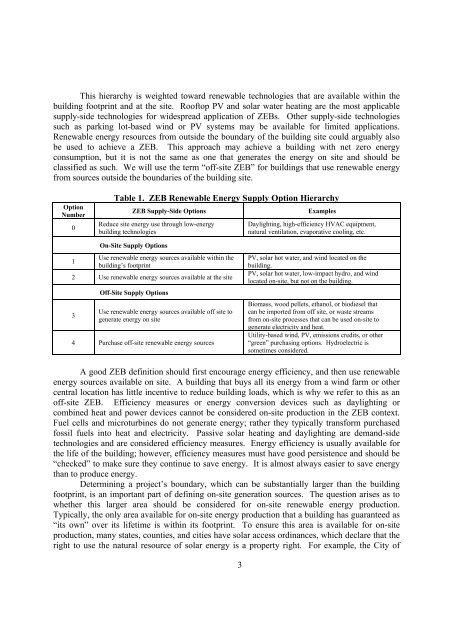Session 1 - Montefiore
Session 1 - Montefiore
Session 1 - Montefiore
Create successful ePaper yourself
Turn your PDF publications into a flip-book with our unique Google optimized e-Paper software.
This hierarchy is weighted toward renewable technologies that are available within the<br />
building footprint and at the site. Rooftop PV and solar water heating are the most applicable<br />
supply-side technologies for widespread application of ZEBs. Other supply-side technologies<br />
such as parking lot-based wind or PV systems may be available for limited applications.<br />
Renewable energy resources from outside the boundary of the building site could arguably also<br />
be used to achieve a ZEB. This approach may achieve a building with net zero energy<br />
consumption, but it is not the same as one that generates the energy on site and should be<br />
classified as such. We will use the term “off-site ZEB” for buildings that use renewable energy<br />
from sources outside the boundaries of the building site.<br />
Option<br />
Number<br />
0<br />
1<br />
Table 1. ZEB Renewable Energy Supply Option Hierarchy<br />
ZEB Supply-Side Options Examples<br />
Reduce site energy use through low-energy<br />
building technologies<br />
On-Site Supply Options<br />
Use renewable energy sources available within the<br />
building’s footprint<br />
2 Use renewable energy sources available at the site<br />
3<br />
Off-Site Supply Options<br />
Use renewable energy sources available off site to<br />
generate energy on site<br />
4 Purchase off-site renewable energy sources<br />
3<br />
Daylighting, high-efficiency HVAC equipment,<br />
natural ventilation, evaporative cooling, etc.<br />
PV, solar hot water, and wind located on the<br />
building.<br />
PV, solar hot water, low-impact hydro, and wind<br />
located on-site, but not on the building.<br />
Biomass, wood pellets, ethanol, or biodiesel that<br />
can be imported from off site, or waste streams<br />
from on-site processes that can be used on-site to<br />
generate electricity and heat.<br />
Utility-based wind, PV, emissions credits, or other<br />
“green” purchasing options. Hydroelectric is<br />
sometimes considered.<br />
A good ZEB definition should first encourage energy efficiency, and then use renewable<br />
energy sources available on site. A building that buys all its energy from a wind farm or other<br />
central location has little incentive to reduce building loads, which is why we refer to this as an<br />
off-site ZEB. Efficiency measures or energy conversion devices such as daylighting or<br />
combined heat and power devices cannot be considered on-site production in the ZEB context.<br />
Fuel cells and microturbines do not generate energy; rather they typically transform purchased<br />
fossil fuels into heat and electricity. Passive solar heating and daylighting are demand-side<br />
technologies and are considered efficiency measures. Energy efficiency is usually available for<br />
the life of the building; however, efficiency measures must have good persistence and should be<br />
“checked” to make sure they continue to save energy. It is almost always easier to save energy<br />
than to produce energy.<br />
Determining a project’s boundary, which can be substantially larger than the building<br />
footprint, is an important part of defining on-site generation sources. The question arises as to<br />
whether this larger area should be considered for on-site renewable energy production.<br />
Typically, the only area available for on-site energy production that a building has guaranteed as<br />
“its own” over its lifetime is within its footprint. To ensure this area is available for on-site<br />
production, many states, counties, and cities have solar access ordinances, which declare that the<br />
right to use the natural resource of solar energy is a property right. For example, the City of











